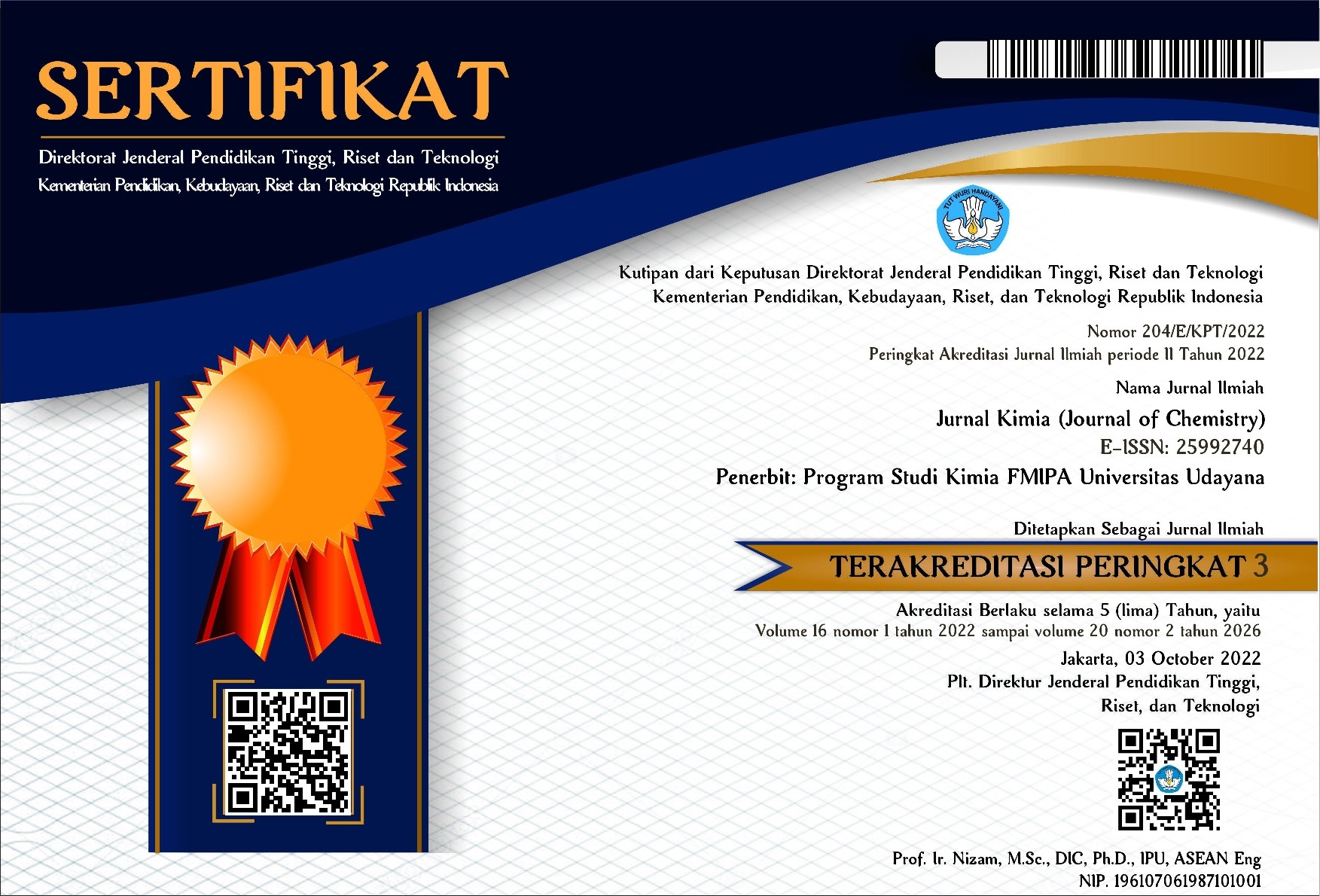UJI AKTIVITAS ANTIBAKTERI EKSTRAK GLIKOSIDA BUAH TERONG BELANDA (Solanum betaceum Cav.) TERHADAP BAKTERI Escherichia coli DAN Staphylococcus aureus
Abstract
Penyakit infeksi yang disebabkan oleh bakteri Escherichia coli dan Staphylococcus aureus dapat ditangani dengan antibiotik. Terong belanda merupakan tanaman yang kaya nutrisi serta bermanfaat menghambat pertumbuhan bakteri. Penelitian ini bertujuan untuk mengetahui aktivitas antibakteri ekstrak glikosida buah terong belanda terhadap bakteri Escherichia coli dan Staphylococcus aureus serta mengidentifikasi senyawa aktifnya. Ekstraksi dilakukan dengan maserasi, pemisahan dan pemurnian dengan KLT, pengujian aktivitas antibakteri dilakukan dengan metode sumur difusi, dan identifikasi senyawa aktif menggunakan spektrofotometri UV-Vis dan FTIR. Maserasi 2000 gram sampel dengan etanol menghasilkan 121,90 gram ekstrak kental. Hasil uji aktivitas antibakteri fraksi hasil kolom (fraksi FI-V) terhadap bakteri Escherichia coli berturut-turut adalah 25,00 mm, 18,75 mm, 23,00 mm, 16,25 mm, dan 9,50 mm. Sedangkan pada bakteri Staphylococcus aureus masing-masing sebesar 29,00 mm, 20,00 mm, 28,00 mm, 18,00 mm dan 11,00 mm. Hasil identifikasi fraksi paling aktif (fraksi I) dengan UV-Vis, pereaksi geser dan FTIR diduga merupakan senyawa flavonoid golongan flavon yang mengandung gugus prenil pada C-6, gugus OH pada C-5,3’,4’ dan mengikat gula pada C-7, serta mengandung gugus fungsi -OH bebas, C-H aromatik, C-O eter, C-O alkohol, C=C aromatic, dan C=O alkohol.
Kata kunci : Antibakteri, Escherichia coli, flavon, Staphylococcus aureus, terong belanda
ABSTRACT
Infectious diseases caused by Escherichia coli and Staphylococcus aureus bacteria can be treated with antibiotics. Dutch eggplant is a plant rich in nutrients and useful for inhibiting the growth of bacteria. This study aimed to determine the antibacterial activity of the glycoside extract of Dutch eggplant against Escherichia coli and Staphylococcus aureus bacteria and identify the active compounds of the eggplant. Extraction was carried out by maceration, while separation and purification were by TLC. The antibacterial activity test was carried out using the diffusion well method, and the identification of the active compounds was done by using UV-Vis spectrophotometry and FTIR. Maceration of 2000 grams of the sample with ethanol produced 121.90 grams of thick extract. The antibacterial activity test resulted in the column yield fraction (FI-V) against Escherichia coli bacteria of 25.00 mm, 18.75 mm, 23.00 mm, 16.25 mm, and 9.50 mm, respectively, while the Staphylococcus aureus bacteria of 29.00 mm, 20.00 mm, 28.00 mm, 18.00 mm, and 11.00 mm, respectively. The identification of the most active fraction (fraction I) with UV-Vis, shear reagent, and FTIR indicated the flavonoid compounds of the flavone group containing prenyl groups at C-6, OH groups at C-5,3',4' and binding sugars at C -7, and contains a free -OH functional group, aromatic CH, CO ether, CO alcohol, C = C aromatic, and C = O alcohol.
Keywords: antibacterial, Escherichia coli, flavones, Solanum betaceum Cav, Staphylococcus aureus.
Downloads
References
Asih, I.A.R.A., Sudiarta, I W., dan Ade, A.W.S. 2015. Aktivitas antioksidan senyawa golongan flavonoid ekstrak etanol daging buah terong belanda (Solanum betaceum Cav.). Jurnal kimia. 9(1): 35-40.
Damayanti, E. dan T. B. Suparjana. 2007. Efek penghambatan beberapa fraksi ekstrak buah mengkudu terhadap Shigella dysenteriae. Prosiding Seminar Nasional Tehnik Kimia Kejuangan. Fakultas Biologi Universitas Jenderal Soedirman. Yogyakarta.
Dwidjoseputro. 1980. Dasar-dasar Mikrobiologi. Djembatan. Malang.
Finar, L. L. 1968. Organic chemistry: Stereochemistry and Natural Product. 2(5). The English Langguage Society and Longman Group Limited. London.
Hastari, P., S. Suratiningsih dan I. Sulistyarini. 2015. Uji Aktivitas Antibakteri Ekstrak Etanol, Fraksi N-Heksan, Fraksi Etil Asetat Dan Fraksi Air Buah Terong Belanda (Solanum betaceum Cav) Terhadap Pertumbuhan Bakteri Shigella dysenteriae. Program Studi S1 Farmasi Sekolah Tinggi Ilmu Farmasi Yayasan Pharmasi. Semarang.
Jawetz, M., dan Adelberg’s. 2012. Mikrobiologi Kedokteran. a.b Tonang. Buku Kedokteran EGC. Jakarta.
Kumalaningsih, dan Suprayogi. 2006. Taramillo (Terung Belanda). Trubus Agrisarana. Surabaya.
Mandal, B.K., Wilkins, Dunbar dan Mayon. 2009. Penyakit Infeksi. Erlangga. Jakarta.
Markham, K. R. 1988. Cara Mengidentifikasi Flavonoid. a.b Kosasih Padmawinata. Penerbit ITB. Bandung.
Ramadhani, S. 2015. Informasi Awal Pengujian Efektivitas Ekstrak Bakteri UBCF 013 Dan UBCR 012 Sebagai Agen Biokontrol Untuk Pengendalian Colletotrichum gloesporioides Pada Cabai Kopay Di Rumah Kaca. Skripsi. Universitas Andalas.
Radji, M. 2011. Buku Ajar Mikrobiologi Panduan Mahasiswa Farmasi dan Kedokteran. Buku Kedokteran EGC. Jakarta.
Sofi, A.R., Sri P.T, R.C., Sunarjono. 2019. Uji Aktivitas Antifungi Ekstrak Etanol Buah Terong Belanda (Solanum Betaceum Cav.) Terhadap Candida Albicans dan Aspergillus Niger Secara In-Vitro. Prosiding Farmasi. 5(2). ISSN: 2460-6472.
Sastrohamidjojo, H. 1991. Kromatografi. Liberty. Yogyakarta.

This work is licensed under a Creative Commons Attribution 4.0 International License





